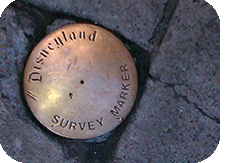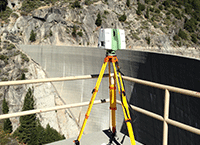|
| This mailer has been provided as an avenue of dispersing information related to the intersection of land surveying and civil engineering. The goal of this newsletter is to foster greater understanding and collaboration between professions. Topics address issues that affect the built environment within which we live. |
|
The Basics of Monument Preservation
Author: Landon Blake, Professional Land Surveyor
Future articles in this series will look at best practices and work products related to monument preservation. Two Categories of Survey Monuments - Survey monuments are a physical mark set by a land surveyor to identify a specific location on the surface of the Earth. Survey monuments can take a large variety of physical forms. They can be as simple as a pavement nail or chiseled mark, or as substantial as a bronze or aluminum disk mounted on a rebar driven to bedrock and encased in concrete. The physical mark will often contain stamping of some type to help land surveyors properly identify it.
There are two (2) basic categories of survey monuments. Survey control monuments are used by surveyors as the basis for all their field measurements. Survey control monuments may be set for temporary use on a single project, but they are more often permanent fixtures meant to be used by land surveyors for decades. These permanent control monuments create a fixed reference frame on which surveyors can base their measurements. This allows measurements from different surveyors, and in different periods of time, to fit together. (NGS is responsible for maintaining a reference frame like this for land surveyors at a national scope.)
Property corner monuments are set by land surveyors to mark the location of a land parcel, right-of-way, or easement. They form a critical part of the evidence needed to locate the limits of land ownership and other rights in land. In fact, property corner monuments can be the most important element of evidence used by a surveyor retracing land boundaries, and its location can supersede historical measurement data in some cases. Why Are Survey Monuments Important? - Although they share a common mathematical foundation, land surveying is inherently more abstract than civil engineering and architecture. The survey monument is very likely the only tangible, physical sign that a land surveyor will leave of his work. Once this physical mark is destroyed, it can be very difficult to reestablish. In these cases, and data or information referenced to the monument is permanently degraded in value, and may become useless. Land surveyors depend on survey monuments to retrace their own work, and to retrace the work of others. Survey monuments for the backbone of land ownership in the United States and serve as the foundational reference frame for the majority of land improvement projects. In some parts of the United States a single property corner monument can control the boundaries of parcels within several square miles. What Damage Occurs When Survey Monuments Are Destroyed? - What damage occurs when a monument is destroyed as part of a land improvement project? Extra costs are now imposed on future land surveyors, land owners, and land improvement projects. These extra costs include the following:
The actual cost of the physical monument and its installation is often just a tiny fraction of these other costs. Why Are Survey Monument Susceptible to Design? - Large public works projects (like roads or canals) are often pushed to the edge of the existing parcels to reduce impacts on the land owners. However, this tendency also makes it more likely that construction of improvements for the project will destroy existing monuments. Because roads, railroads, canals and other features also often mark existing boundaries between parcels, this is often where new property corner monuments are set.
On smaller site design projects any improvements to walls, fences, landscaping, or road frontage around the parcel perimeter is also likely to disturb or destroy monument set to mark the parcel boundary.
Road improvement projects also frequently remove, bury, or pave over survey monuments set within the road surface, often at the centerline. Conclusion - In our next article we will examine the requirements in the California Business and Professions Code related to monument preservation for public agencies, civil engineers and land surveyors. |
|
|
|
|
|
|
|
|
|
|
|
|
|
|
|
|
|
|
|
|
|
 This is the first article in a series that will be exploring monument preservation on land improvement projects. (These projects include large public works projects on infrastructure like roads, pipelines, and levees, but also smaller site design for commercial, industrial and residential projects.) The accidental destruction of survey monuments during construction of a land improvement project can expose a design firm to additional liability and can also lead to problems with the government agencies that oversee professional design licenses. Monument destruction is an easy problem to prevent, but a very difficult (and expensive) problem to fix.
In this first article we will discuss the very basics of monument preservation. This first article will discuss the following topics:
This is the first article in a series that will be exploring monument preservation on land improvement projects. (These projects include large public works projects on infrastructure like roads, pipelines, and levees, but also smaller site design for commercial, industrial and residential projects.) The accidental destruction of survey monuments during construction of a land improvement project can expose a design firm to additional liability and can also lead to problems with the government agencies that oversee professional design licenses. Monument destruction is an easy problem to prevent, but a very difficult (and expensive) problem to fix.
In this first article we will discuss the very basics of monument preservation. This first article will discuss the following topics:
